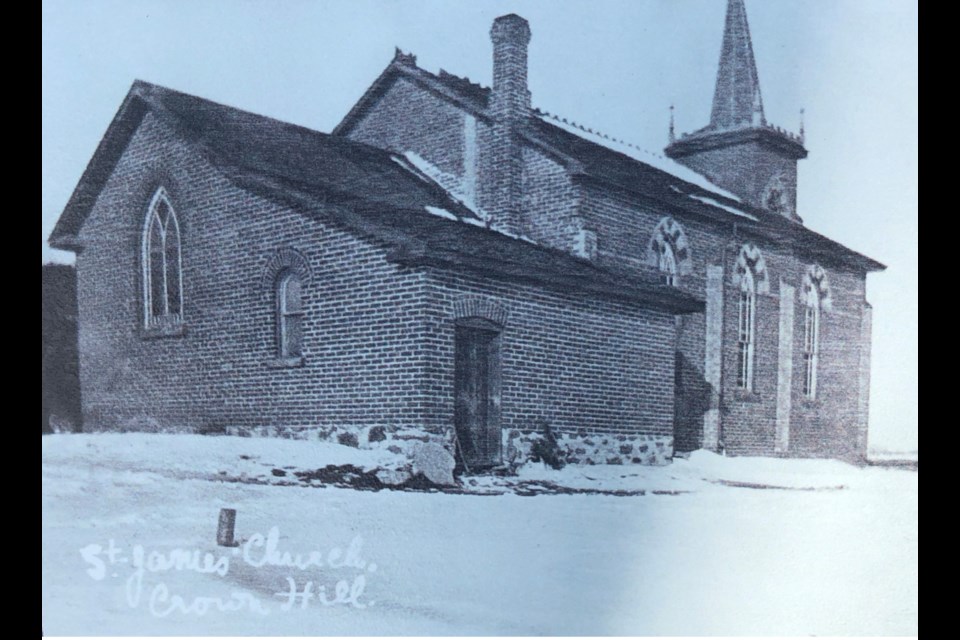This ongoing series from Barrie Historical Archive curator Deb Exel shows old photos from the collection and one from the present day, as well as the story behind them.
St. James Church — Crown Hill
From the quiet churchyard, you can see Barrie in the distance. Even though it is just beyond the city limits of Barrie and next to a busy highway, the peaceful stillness on the hill behind the old St. James church is astonishing.
When John and Charlotte Partridge came to Canada in 1819 from Devon, England, they named the place they settled Crown Hill as it reminded them of a high hill of the same name back home.
Crown Hill is located at the boundaries of Oro and Vespra (now Springwater) townships.
To get an sense of the history of settlement in this area, the overall strategy was about connecting the naval depot in Penetanguishene to Kempenfelt Bay. Penetanguishene Road would be that important conduit linking these two points.
Leaving the village of Kempenfeldt, Crown Hill was the next ‘major’ village along this route. In 1819, the government offered 200 acres on either side of the road on the condition that the settlers build a house, clear 10 acres next to the road and keep half of the road in front of their property maintained.
This land-grant incentive was designed to keep the road open so the troops stationed at Penetanguishene could be refreshed with supplies. Land grants were also settled on retired military from the War of 1812 and European Peninsular War, immigrants and the children of United Empire Loyalists. All petitions for Crown lands from settlers of African descent or veterans of the War of 1812, were granted 100 acres on the second concession of Oro.
By 1829, approximately 26 families had settled between the village of Kempenfeldt and Morrison’s Corners (Craighurst). Many of these early families, just to name a few, contributed to the development of Crown Hill, Barrie and the area:
* John L. Chappell’s family, settled in 1848, established the North Simcoe 4H Scholarship and Trophy. John, whose hobby was wood carving, has pieces in the National Museum of Canada. John’s great-great-grandson now operates the family farm.
* George Hickling, although he had a trade, joined His Majesty’s Navy as a young man, sailing on the ship Surprise. Piracy was considered patriotic business back then and men were well rewarded for captures. Hickling received certificates of captures in 1801 and 1802 and had been part of a risky recapture of a British ship in Jamaica. He came to Canada in 1819, receiving a 200-acre land grant. Unfortunately, his wife died in England but his children joined him in Canada and their farm remained in the family until 1930.
* William Larkin had settled prior to 1837 and built one of the first brick houses in the area. The bricks used for his home were believed to have been made in Fisherman’s Point, about half a mile from his property.
* John Lawrence built the first house north of the village of Kempenfeldt in 1819. In 1844, the Wesleyan Methodist Church bought two acres from the Lawrence’s for a chapel and burying ground. John’s son, although not an actual doctor, was called Doctor Lawrence because of his use of herbs for medicinal purposes, which he learned from the Indigenous people. John’s granddaughter lived on the south side of Little Lake, operating a boat and cottage rental business in what became known as Lawrence Park.
* Edward Luck immigrated to Albany, N.Y., from Northampton, England in 1803 and by 1820, was settled on the Penetanguishene Road. Ed Jr. taught school at the Crown Hill school for 22 years. His son, Thomas, bought the farm in 1876, selling a lot in 1891 to the Free Methodist Church for $1. The farm’s maple bush provided a business in syrup, lumber and stove wood. In the summer, the Free Methodists used the maple bush for tent meetings. The Luck family farmed this property until 1957.
* Joseph Drury settled in Crown Hill in 1819, along with his sons Thomas and Richard. Joseph died tragically in the bush during a snowstorm in 1823. His sons had to work away from their farm building corduroy roads and doing other labour in order to make money. Richard Drury helped to open Sunnidale Road in 1833. Read more about the Drury family here.
* Later, in 1912, A.W. Partridge and E.C. Drury were key to founding the Crown Hill Telephone Company, which was maintained by families that included the Browns, Chappells, Coutts, Drurys, Jamiesons, Partridges and Richardsons. This local telco continued to operate independently until 1960.
* There are many other families with deep ties to the little community and several still reside in Crown Hill or nearby.
In 1902, the Barrie Examiner wrote that the settlers of Crown Hill were “the pioneers who saw the landscape clad with virgin forest transformed into the magnificent farmlands that lie along the Penetanguishene Road.”
Crown Hill continued to develop as an agricultural community. Records show that from 1869 until the 1930s, many Crown Hill families took part in the British Home Children program in order to have more help on their farms and in their homes.
In 1981, the International Plowing Match was held on the property of George Atkinson, bringing huge crowds to the village of Crown Hill and its beautiful, rolling farmland.
Thomas Mair, formerly of Yorkshire, England, settled in Vespra in 1819. He assisted George Oliver in establishing the mill at Midhurst in 1825 and also imported Durham cattle, building a fine, prize-winning herd.
It was Thomas Mair, in 1852, who deeded one acre for a church and cemetery at the southeast corner of lot 11 Vespra Township.
St. James Anglican Church, erected 1855, was the first church built in Crown Hill. An annual garden party in support or the church was held for 25 years at William Partridge’s home on Penetanguishene Road.
In 1906, Vespra Township granted a road allowance and the cemetery was enlarged by one and one-third acres. At some point over the years, the red brick church received its current white finish.
Many of Crown Hill’s first residents and their descendants are buried in cemetery behind the church. The last service of St. James Anglican Church was held on Easter Sunday, 1970.
Since 1984, Holy Cross St. Nektarios Greek Orthodox has called the little county church home.


